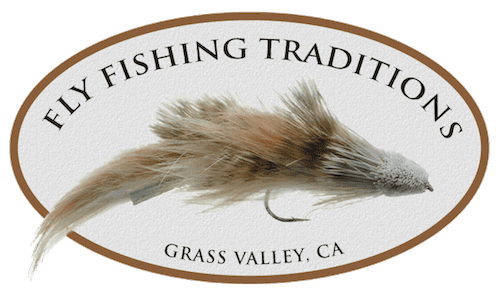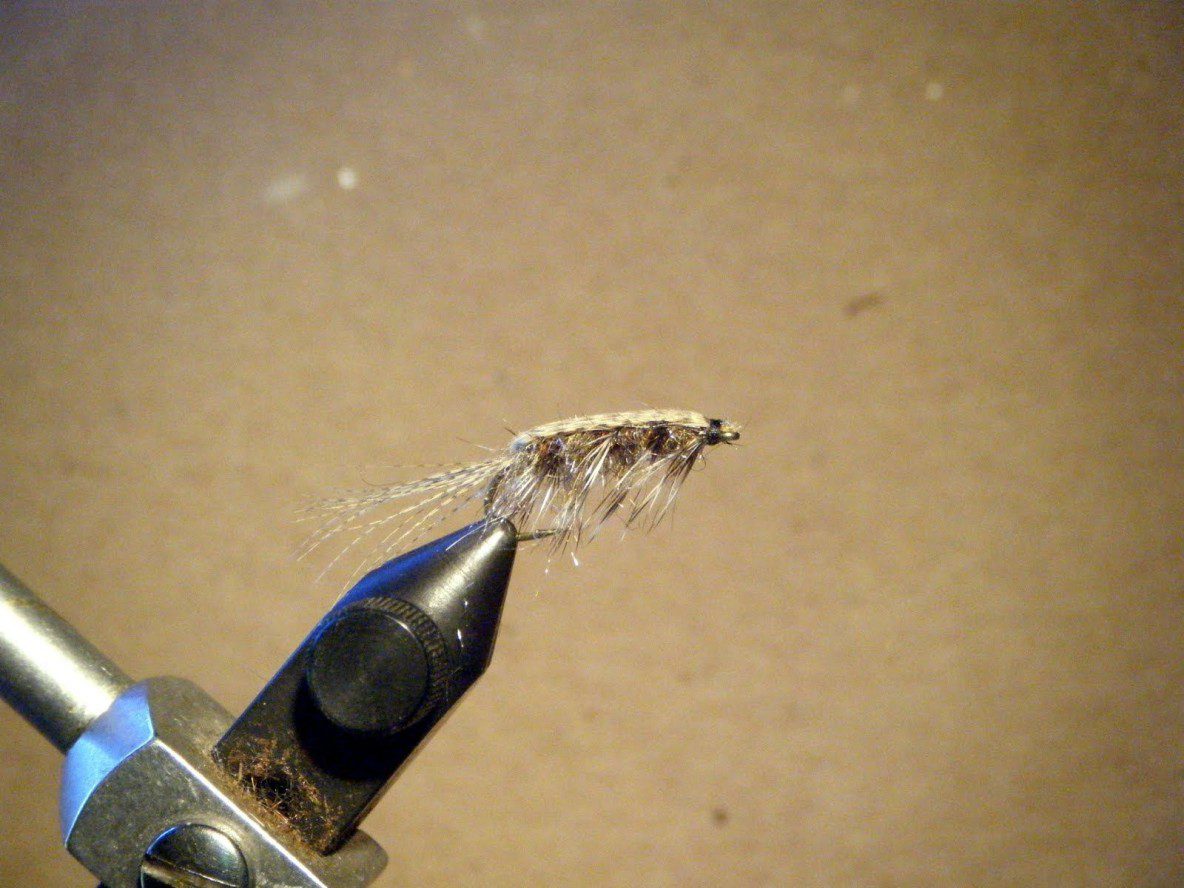I fished a lake near Island Park, Idaho this past weekend as a part of Phil Rowley’s Stillwater School, I’ll get into that in another post, and found callibeatis mayflies, swimming in the shallows as well as many shucks. There were callibeatis emergers struggling to escape their shucks. I went right into my box and picked a Rickard’s Callibeatis nymph and went to work. The fish were on to the fly as soon as I found out where the were hanging out. Others were using a Pheasant Tail Nymph, but I’d say my nymph out fished the PT.
This pattern is a great “Go To” pattern to be used as a searching fly or to match the hatch. You need to have this fly in your stillwater box.
Rickard’s Callibaetis Nymph Recipe
Hook – 2x – Tie sizes 12 through 14, Size 10 early in the season.
Tail – Wood Duck or Dyed Mallard
Rib – Copper Wire
Body – Hares Ear
Hackle – Grizzly. Use straight grizzly for the tan version. Use olive dyed grizzly for the olive version.
Rickards Callibaetis Nymph Notes
- It is recommended to tie this pattern in colors of tan, olive, black and rust/cinnamon.
- This pattern is tied un-weighted as it is designed to be fishing up near the surface.
- This fly is named the “Callibeatis Nymph” but it is a “Go To” fly when ever fish are working near the surface, feeding on midges or other bugs. It is an impressionistic fly. You can retrieve it or let it sit.
- When selecting wood duck fibers for the tail don’t tie them in so they curve to one side or the other. Make sure they are facing straight back.
- This fly should be presented with a floating or intermediate line. Use short slow pulls. You want to keep this fly in the top foot of water, so adjust your retrieve accordingly.
- When fishing any fly near the surface you need to remember to use a longer leader, 12 to 15 feet long, tapered down to 4x or 5x. You need the longer leader especially when using a floating line because the floating line makes surface disturbance when you cast, strip and then retrieve the fly. The determining factor is the clarity of the water.
- This fly is typically fished in the in the top 2 feet and is seldom fished it deep.
Tying Instructions
 1. Place hook in vice and start thread wrap behind the eye of the hook. Cover the hook back to the hook bend.
1. Place hook in vice and start thread wrap behind the eye of the hook. Cover the hook back to the hook bend. 2. Pinch off a a small bunch of wood duck fibers. You want this to be a sparse bunch. Make sure that when you tie in the tail that the fibers point straight back and don’t bend to one side or the other. This provides more movement of the tail. Tie the tail in standard length about 1/2″ to 3/4″ long. Tie in the tail, bind it down.
2. Pinch off a a small bunch of wood duck fibers. You want this to be a sparse bunch. Make sure that when you tie in the tail that the fibers point straight back and don’t bend to one side or the other. This provides more movement of the tail. Tie the tail in standard length about 1/2″ to 3/4″ long. Tie in the tail, bind it down. 3. When done, pull the fibers back towards the tail and bind down the remainder. This will be used for a back.
3. When done, pull the fibers back towards the tail and bind down the remainder. This will be used for a back. 4. Tie in the copper rib at the tie in point at the tail. Use standard gauge wire, not too small.
4. Tie in the copper rib at the tie in point at the tail. Use standard gauge wire, not too small. 5. Tie in the grizzly saddle hackle. For the olive version tie in an olive grizzly hackle.Tie the hackle in by its tip. You don’t want this hackle to be palmered.
5. Tie in the grizzly saddle hackle. For the olive version tie in an olive grizzly hackle.Tie the hackle in by its tip. You don’t want this hackle to be palmered. 6. Tie in a dubbing loop that is about 5 inches long. For the olive Callibaetis Nymph use olive Hares Ear dubbing. Place the fur cross-wise into the dubbing loop. Hold the material with your hand to keep the material from spinning and then spin the dubbing loop tool while holding the material. Let go of the material and it will spin itself. Pick out the excess to create a consistent rope. You can add more material below to extend the length of the dubbing rope.
6. Tie in a dubbing loop that is about 5 inches long. For the olive Callibaetis Nymph use olive Hares Ear dubbing. Place the fur cross-wise into the dubbing loop. Hold the material with your hand to keep the material from spinning and then spin the dubbing loop tool while holding the material. Let go of the material and it will spin itself. Pick out the excess to create a consistent rope. You can add more material below to extend the length of the dubbing rope. 7. Once you have the correct amount of material in the rope continue spinning the dubbing loop tool until you have a tight dubbing rope.
7. Once you have the correct amount of material in the rope continue spinning the dubbing loop tool until you have a tight dubbing rope. 8. Spin the loop tool a bit more and start placing wraps one in front of the other towards the eye of the hook. Wrap the rope forward and tie the rope off. Clip off the remaining rope.
8. Spin the loop tool a bit more and start placing wraps one in front of the other towards the eye of the hook. Wrap the rope forward and tie the rope off. Clip off the remaining rope. 9. Wrap the copper rib forward, spaced closely to create segmentation about 10 times or more on a 2x hook. Tie off the wire at the head of the fly.
9. Wrap the copper rib forward, spaced closely to create segmentation about 10 times or more on a 2x hook. Tie off the wire at the head of the fly. 10. Wrap the hackle forward with 3 turns only. Tie off the hackle at the head.
10. Wrap the hackle forward with 3 turns only. Tie off the hackle at the head. 11. Pull the excess tail material over the top and over the eye of the hook to form a back. Turn you vise to check that the fibers are staying directly over the top of the fly and not over to one side or the other.
11. Pull the excess tail material over the top and over the eye of the hook to form a back. Turn you vise to check that the fibers are staying directly over the top of the fly and not over to one side or the other. 12. Whip finish the head. Trim the hackle fibers at an angle along the sides so the hackle fibers are facing mostly downwards. Apply head cement and you’re done.
12. Whip finish the head. Trim the hackle fibers at an angle along the sides so the hackle fibers are facing mostly downwards. Apply head cement and you’re done.
How to fish Rickards’ Callibeatis Nymph
- Use this fly when you see fish working on the surface. Remember that you need to fish this fly very slowly or with little or no movement at all.
- Start with an intermediate line and use a slow hand twist retrieve, very slow.
- You can also use a short slow pull with an emphasis on slow.
- You can use this fly when sight fishing and if you see a rise ring, cast to the right or left of the ring and the start the short slow pull.
- When using a floating line, grease your leader within 4 to 6 inches of the fly, using a longer leader of 12 to 15 feet and let it sit. Or you can let it sink a bit and retrieve it with a short slow pull or slow hand twist speed. Emphasis on slow.
- You want this fly to look like a bug getting ready or is just emerging. The fish will not be looking for much movement.

